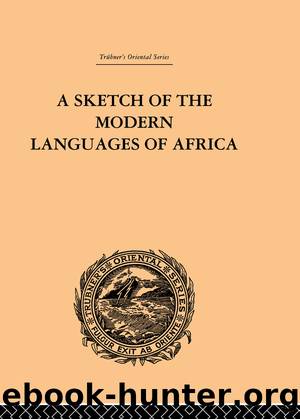A Sketch of the Modern Languages of Africa: Volume I by Robert Needham Cust

Author:Robert Needham Cust [Cust, Robert Needham]
Language: eng
Format: epub
ISBN: 9781136372728
Barnesnoble:
Publisher: Taylor & Francis
Published: 2013-11-05T00:00:00+00:00
Chapter X.
Nuba-Fulah Group.
To F. Müller must be ascribed the credit and the responsibility of adding a new Class to the previous Classification of African Languages. Perhaps Renan was the first who distinctly called for a Hamitic Group, but I do not find any trace, except in the works of F. Müller, of the Group, the name of which stands at the head of this Chapter. Latham as far back as 1847, at the Meeting of the British Association, shadows out the idea of a Nubian Group, and Logan in his review of our knowledge of the Languages of Africa in 1854, particularly of the Tumále, the nature of which had just been revealed by Tutshek, had clearly realized the existence of a Group of Languages, perhaps even a Family, which could not be subordinated to Hamitic, Hottentot, Bántu, or Negro. Other inquirers into separate Languages have arrived at the conclusion, that such and such a Language was not Hamitic, and for the same reasons not Hottentot. The features of the Bántu Family were too marked to admit such Languages as the Nuba. To throw them back into the undefined Negro Group would have been only to shirk the question. On the West Coast of Africa, South of the great Sahára, one great and remarkable Language, the Fulah, with several Dialects, gradually separated itself from the Negro Group, and seems to require separate treatment. Ethnological considerations, though foreign to the scope of this work, seemed to point in the same direction. F. Müller in his Universal Ethnology suggested a new Group, the Nuba-Fulah, with two Sub-Groups, A. Nuba, B. Fulah. This arrangement commends itself to my judgment from its convenience, as enabling me to pass on from the confines of the Hamitic Language-Field, and sweep into this new Group all that is not strictly Bántu, or which cannot be conveniently treated as Negro. The enormous size of these Divisions of the subject justify any attempt to reduce them which does not lead to obvious inconsistencies. The Sub-Groups will be treated separately. My Geographical method is somewhat strained by this proceeding, but I hope that I have been consistent.
A. Nuba Sub-Group.
It is named after the well-known Language of the people who inhabit the Basin of the Nile from the first to the second Cataract. It clearly consists of a row of distinct Languages, which are gradually coming under observation. They appear to have distinct Seed-plots. It is possible that a fuller supply of Materials may lead to some indication of unity of origin: with the present stock of information no such union can be asserted. The following Languages are provisionally entered, with power to add more in the direction of the undiscovered Regions of the River Welle: on the other sides the Sub-Group is shut in by the Hamitic and Negro Groups, and the Bántu Family.
NUBA.
KOLDAJI.
TUMÃLE.
KONJÃRA.
KWÃFI.
MASAI.
BERTA.
KAMAMÃL.
FUNJ.
TABI.
HAMEJ.
GOLO.
KREJ.
SEHRE.
NYAM-NYAM.
MONBUTTO.
Download
This site does not store any files on its server. We only index and link to content provided by other sites. Please contact the content providers to delete copyright contents if any and email us, we'll remove relevant links or contents immediately.
| Africa | Americas |
| Arctic & Antarctica | Asia |
| Australia & Oceania | Europe |
| Middle East | Russia |
| United States | World |
| Ancient Civilizations | Military |
| Historical Study & Educational Resources |
Goodbye Paradise(2974)
Men at Arms by Terry Pratchett(2408)
Tobruk by Peter Fitzsimons(2065)
Pirate Alley by Terry McKnight(1911)
Arabs by Eugene Rogan(1841)
Borders by unknow(1791)
Belonging by Unknown(1473)
The Biafra Story by Frederick Forsyth(1327)
It's Our Turn to Eat by Michela Wrong(1305)
Botswana--Culture Smart! by Michael Main(1239)
A Winter in Arabia by Freya Stark(1226)
Gandhi by Ramachandra Guha(1198)
Coffee: From Bean to Barista by Robert W. Thurston(1184)
Livingstone by Tim Jeal(1154)
The Falls by Unknown(1143)
The Source by James A. Michener(1137)
The Shield and The Sword by Ernle Bradford(1102)
Egyptian Mythology A Fascinating Guide to Understanding the Gods, Goddesses, Monsters, and Mortals (Greek Mythology - Norse Mythology - Egyptian Mythology) by Matt Clayton(1089)
Africa: Altered States, Ordinary Miracles by Richard Dowden(1080)
